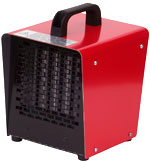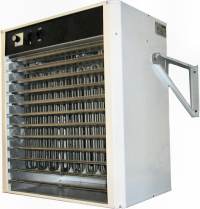
| ||||
W. Tombling Ltd.
Wembley House
Dozens Bank
West Pinchbeck
Spalding
Lincolnshire
PE11 3ND
U.K.


How warm should an electric fan heater get?
Broadly speaking fan heaters can be divided into:-
The small domestic 2 or 3kw units found in diy outlets, designed for heating individuals or small rooms.
Larger commercial 3 to 30kw heaters designed to heat medium to large buildings.
With the exception of the VKX2 portable heater all of our fan heaters are of the latter type. They are specially designed to recirculate high volumes of air until the air within the space reaches the desired temperature; this type of heater is called a space heater.
Temperature rise through a fan assisted heater
The temperature rise through a fan assisted heater depends on the output of the heater (kw), and the airflow through the heater (m3/s) and is defined as:-
Temperature rise (C) = heater size (kw) / air volume (m3/s) x 1.25
For a fixed size of heater, the temperature rise through it decreases as the air flow increases, for example:
A 20kw fan heater with an air volume of 3m3/s has a temperature rise of 4.8C.
20 / (3.3 x 1.25) = 4.8C
While a similar 20kw heater with an air volume of 10m3/s has a temperature rise of 1.6C, less than half!
20 / (10 x 1.25) = 1.6C
The important point to note is that both heaters are actually delivering 20kw of heat. But to the uninitiated because the outlet temperature is lower, the second heater appears less effective. This is not the case as the full 20kw of heat is still being transferred into the surrounding air.
Why do space heaters have low outlet temperatures
To efficiently heat a room or building the air in it should pass through the space heater several times per hour.
Because domestic fan heaters are designed to heat small areas, they have relatively low air throughput which results in high outlet temperatures. People standing immediately in front of them feel a stream of very warm air; this is possible because the heat does not have to spread over a wide area.
In contrast space heaters are designed to spread warmth over a large area, consequently they have powerful fans which circulate large volumes of air. The result is for a given output they have a much lower outlet temperature. Users who do not understand the relationship between air volume and outlet temperature often mistakenly take this to mean the heater is faulty!
Why does the outlet air sometimes feel cool?
When a person places their hand in front of a space heater they expect to feel warmth. However they will only do so when the air coming from the heater is above skin temperature.
Average human skin temperature is 32 to 34C, so to feel warm the outlet temperature of a heater must be higher than 33C.
The outlet temperature of a fan heater is defined as:
Outlet temperature = inlet temperature (C) + temperature rise (C)
As explained above, space heaters have a low temperature rise, so if the air entering the heater inlet is very cold, it is likely the outlet air will feel cool even though the heater is working correctly.
For example: consider an EA14 wall mounted
space heater which has a maximum temperature lift of 20C,
at low fan speed. The inlet temperature (i.e.
the surrounding air) has to be at least 13C (33C-20C) before any warmth is felt.
maximum temperature lift of 20C,
at low fan speed. The inlet temperature (i.e.
the surrounding air) has to be at least 13C (33C-20C) before any warmth is felt.
Below 13C the heater will be working to raise the temperature of the building, but the outlet air will feel barely warm. This often leads users to mistakenly believe their heater is faulty, especially first thing in the morning, where the building and inlet temperature could be as low as 5C.
What causes the outlet air to be cold?
Low outlet temperatures are caused by cold air around the heater and its inlet. The main causes are:
• A space heater which is too small for the area it is installed in. This happens when users do not carry out a heatloss calculation. When a heater is too small it will run continuously but not be able to raise the surrounding air temperature.
• Trying to use a space heater as a ‘spot heater’ to warm individual workers or small area’s that are part of a much bigger space. Again the heater will not be able to raise the inlet temperature.
• Using space heaters outdoors, or in buildings where doors and windows are open allowing cold air to circulate around the heater.
How does this affect me?
Only use space heaters indoors and always perform a heatloss calculation. Guessing what size heater is required will lead to problems later.
Do not use space heaters:
• As spot heaters, space heaters are designed as ‘whole room heaters’. If you need to heat individual workers either use a small fan heater specifically designed for the task such as out VKX2 portable electric heater, or use a radiant heater.
• Outdoors or where the inlet air is very cold. Again consider radiant heaters instead.
• Where doors or windows are left open.
Properly sized space heaters installed in suitable buildings will quickly create a comfortable working environment. Most of the problems users encounter result from not doing a heatloss calculation, or using them for unsuitable applications.
Further reading
Are space heaters suitable for my building?
What size space heaters do I need?
Is my electricity supply suitable?
How much do electric space heaters cost to run?
If you found this page useful, please take a moment
to tell a friend or colleague about it.
Copyright � 2003/6, W. Tombling Ltd.